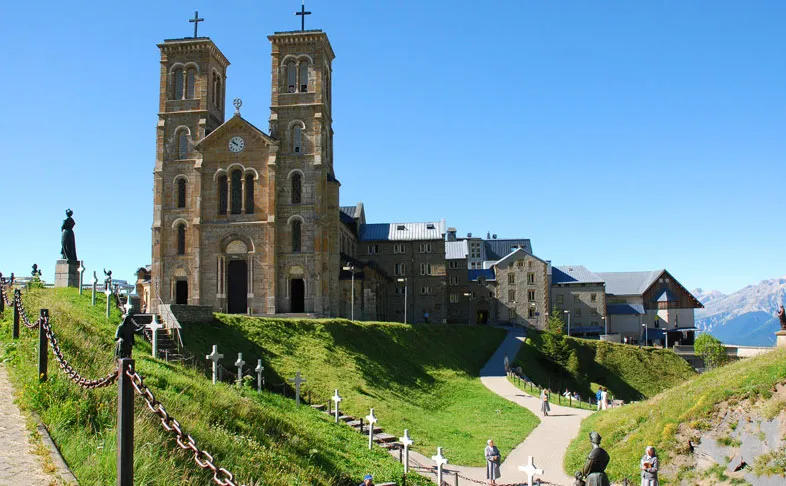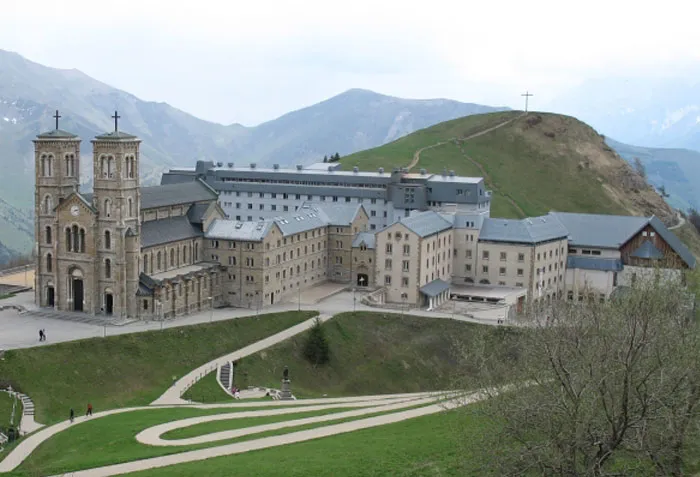
Introduction
The Shrine of Our Lady of La Salette or, simply, Sanctuary of Our Lady of La Salette is a large Catholic Marian pilgrimage centre built on the site of an apparition of the Virgin Mary in 1846. This Marian apparition, officially recognized as authentic by the local bishop in 1851 and 1855, resulted in the construction of a church at the top of the village of La Salette-Fallavaux, near Corps (Isère), France. In 1879 the church was officially consecrated and promoted to the rank of minor basilica.
The sanctuary of La Salette is one of the great Marian sanctuaries built in France. Installed in the middle of the mountains, at an altitude of 1,800 m, it welcomes around 300,000 pilgrims a year.
Since its construction, the sanctuary has continued to be expanded and to see new buildings added to the existing one. The reception of pilgrims and their accommodation is provided by a hostelry integrated into the sanctuary. Outside, the various scenes of the Marian apparition are materialized by life-size bronze statues.
Access to the sanctuary was a problem for a long time, for lack of an existing road before the middle of the 19th century. A first road was cut in the mountain, but it had a very steep slope, causing problems for vehicles. In the 1960s, a new road was started and built, on a new route, allowing cars and coaches to get on it without difficulty. Despite this new route, the Laffrey descent has been the subject of three serious accidents to date, causing the death of 98 pilgrims.
The Sanctuary is located in the Pays de Corps, on the heights of the commune of La Salette-Fallavaux, between the Beaumont massif and the Valgaudemar valley, at an altitude of nearly 1,800 m. Until the middle of the 19th century, the site was wild and unknown, no road or path led there. There were only shepherds’ paths. Only a few shepherds with their flocks ventured onto the slopes of Mount Gargas to take advantage of the mountain pastures.
History of Sanctuary of Our Lady of La Salette, France
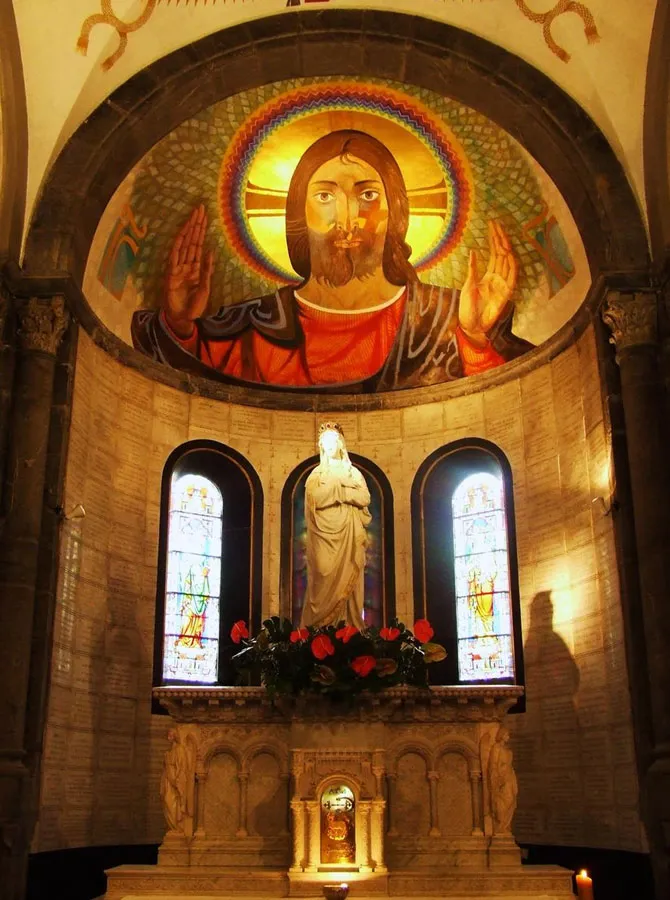
The history of the site and the Sanctuary begins with the Marian apparition of La Salette on Saturday September 19, 1846. Two young shepherds, Mélanie Calvat and Maximin Giraud, see a “beautiful lady” appear in a dazzling light, in tears, who speaks to them. In the evening, they talk about it to their masters. Widow Pra (known as widow Caron), Mélanie’s mistress, thinks that they have seen the Blessed Virgin and the children are asked to tell the priest of La Salette everything.
They do it the next day, Sunday morning. The priest wept with emotion, took notes and, again in tears, spoke of the event in his sermon. The bishop is informed, and opens a canonical inquiry. September 19, 1851 Mgr Buillard, Bishop of Grenoble officially recognizes the apparition as “authentic”, and launches the construction of a sanctuary on the very place of the apparition.
Architecture of Sanctuary of Our Lady of La Salette, France
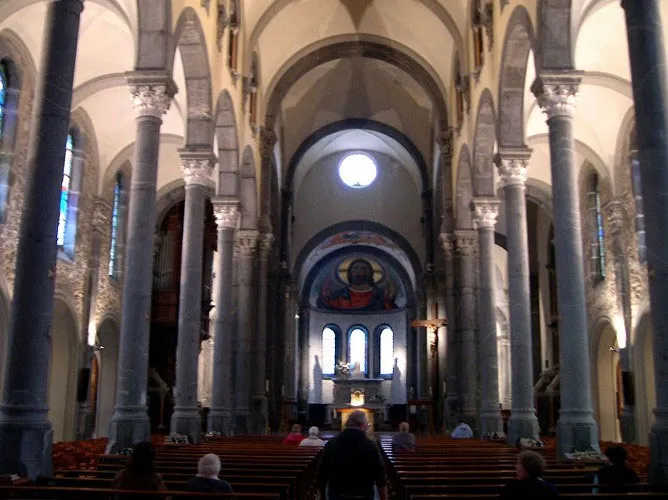
Before the official recognition of the Marian apparition (in 1851), the bishop opened negotiations in 1849 to buy the land for the creation of the future sanctuary (land to be purchased in 1851).
May 1, 1852, the next solemn benediction of the first stone of the sanctuary which he undertakes to build in the mountain, on the very place of the apparition, is announced. The laying of the first stone takes place on May 25, 1852, by Mgr Chartrousse, Bishop of Valence, in the presence of Mgr Bruillard, Bishop of Grenoble, and 1,500 pilgrims. The construction ends in 1879. Since then, and until our days, the sanctuary does not cease being enlarged and modified. In 1864, life-size bronze statues were installed on the very site of the apparition.
The plans for the church were designed by the architect Alfred Berruyer N. The construction work took a little longer than expected, because the companies encountered serious problems in the delivery of materials: apart from the stone and the lime, everything had to be mounted on the back of a mule. The sand was extracted from the Drac (and also transported by mule). In 1865, the entire central part of the church was completed. But the ten side chapels that we see today will not be built until 1894.
August 20, 1879, the church is officially consecrated, and at the same time, it is promoted to the rank of minor basilica, under the presidency of Cardinal Guibert, Archbishop of Paris, in the presence of the bishops of Grenoble, Chambéry, Besançon, Marseille, Fréjus, Valence, Viviers, Digne and Bishop Mermillod. During this celebration, the statue of Our Lady of La Salette is officially crowned.
Our Lady of La Salette

Our Lady of La Salette (French: Notre-Dame de La Salette) is a Marian Apparition reported by two French children, Maximin Giraud and Mélanie Calvat, to have occurred at La Salette-Fallavaux, France, in 1846.
On 19 September 1851, the local bishop formally approved the public devotion and prayers to Our Lady of La Salette. On 21 August 1879, Pope Leo XIII granted a canonical coronation to the image now located within the Basilica of Our Lady of La Salette. A Russian-style tiara was granted to the image, instead of the solar-type tiara used in the traditional depictions of Our Lady during her apparitions.
Places dedicated to Our Lady of La Salette outside of France include a sanctuary in Oliveira de Azeméis, in Portugal, a chapel in San Miguel de Allende, Guanajuato, in México, as well as a national shrine in Attleboro, Massachusetts, and a shrine in Enfield, New Hampshire, in the United States, both known for their displays of Christmas lights.
History of Our Lady of La Salette

In 1846 the village of La Salette consisted of eight or nine scattered hamlets. The population was about 800, principally small farmers with their families and dependents. On the evening of Saturday, 19 September 1846, Maximin Giraud and Mélanie Calvat (called Mathieu) returned from the mountain where they had been minding cows and reported seeing “a beautiful lady” on Mount Sous-Les Baisses, weeping bitterly.
They described her as sitting with her elbows resting on her knees and her face buried in her hands. She was clothed in a white robe studded with pearls; and a gold colored apron; white shoes and roses about her feet and high headdress. Around her neck she wore a crucifix suspended from a small chain.
According to their account, she continued to weep even as she spoke to them, first in French, then in their own dialect of Occitan. After giving a secret to each child, the apparition is said to have walked up a hill and vanished.
After five years of investigation, the Bishop of Grenoble, Philibert de Bruillard announced in 1851 that the apparition was likely to be a true revelation and authorised the commencement of the following of Our Lady of La Salette. This determination was later confirmed by his successor, Bishop Ginoulhiac.
Apparition
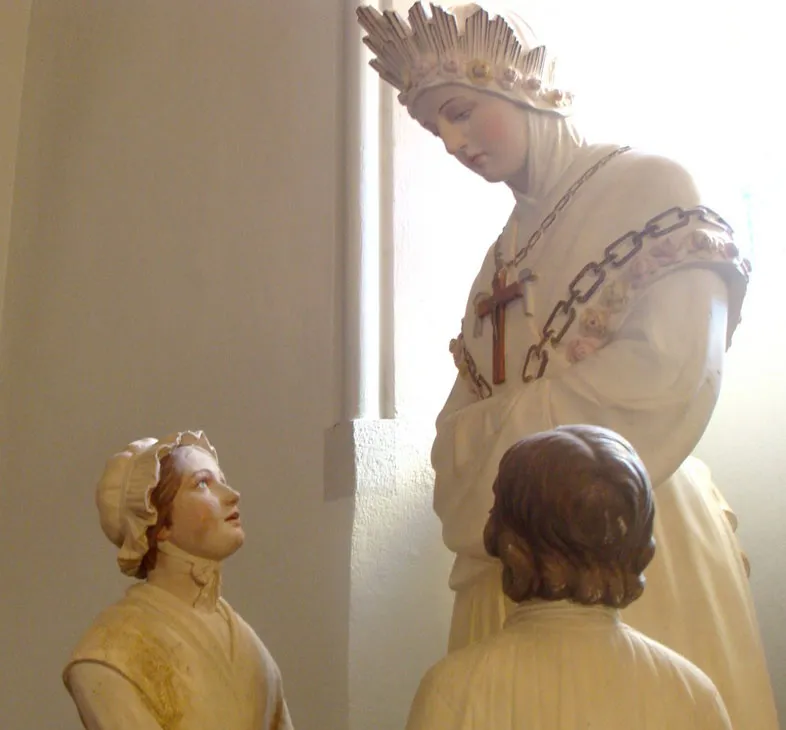
According to the children’s account, the message of the Virgin was a call for the people of the world to return to God. She equated the people’s sinfulness to a harvest being spoiled.
John Vianney, John Bosco, and Joris-Karl Huysmans were all influenced by La Salette. The spirit of La Salette is said to be one of prayer, conversion, and commitment. René J. Butler of the La Salette Missionaries of North America says “The whole purpose of the Apparition of Our Lady of La Salette was reconciliation.”
Pope John Paul II stated, “As I wrote on the occasion of the 150th anniversary, ‘La Salette is a message of hope, for our hope is nourished by the intercession of her who is the Mother of mankind.”
Father Hippolyte Delehaye, president of the Bollandist Society, saw in the words attributed to Our Lady of La Salette an avatar of the false Letter of Jesus Christ on Sunday (Carta dominica).
Inquiry
Sensation about Our Lady of La Salette arose when Mélanie and Maximin made their message public, which caused the bishop of Grenoble to investigate the apparition. During the investigation, a number of accusations were made against the visionaries, including the assertion that the apparition was actually just a middle-aged woman named La Merlière.
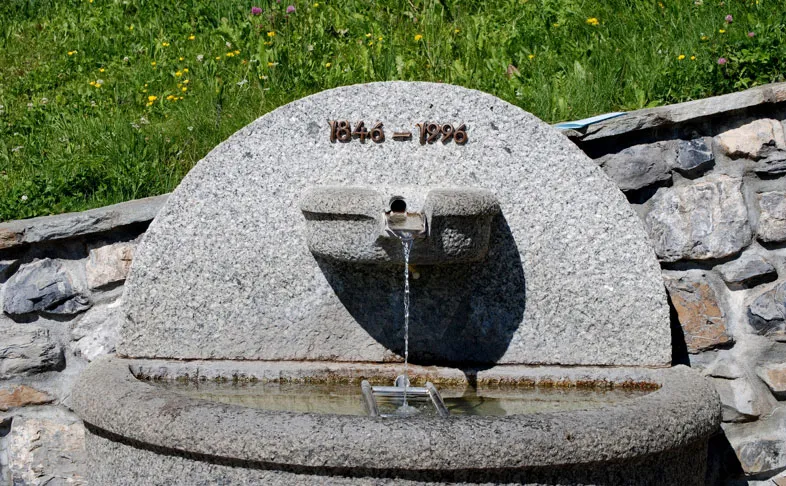
Secrets
No mention of secrets is made in the children’s first accounts. The children later reported that the Blessed Virgin had confided a special secret to each of them. These two secrets, which neither Mélanie nor Maximin ever made known to each other, were sent by them in 1851 to Pope Pius IX on the advice of de Bruillard. It is assumed that these secrets were of a personal nature. Maximin advised the Marquise de Monteyard, “Ah, it is good fortune.”
Fate of the Children
Maximin Giraud, after an unhappy and wandering life, returned to Corps, Isère, his native village, and died on 1 March 1875 aged 39. Mélanie Calvat died as a Catholic nun at Altamura, Italy, on 15 December 1904.
Legacy
The Missionaries of Our Lady of La Salette were founded in 1852 by Philbert de Bruillard, Bishop of Grenoble, France, and presently serve in some 25 countries.
The U.S. National Shrine of Our Lady of La Salette is located in Attleboro, Massachusetts. Known simply as “La Salette” locally, it is famous for its Festival of Lights, held annually during the Christmas season, where the grounds are decorated with elaborate Christmas light displays. The shrine is visited by over 1 million people per year and hosts many pilgrimages and retreats throughout the year.
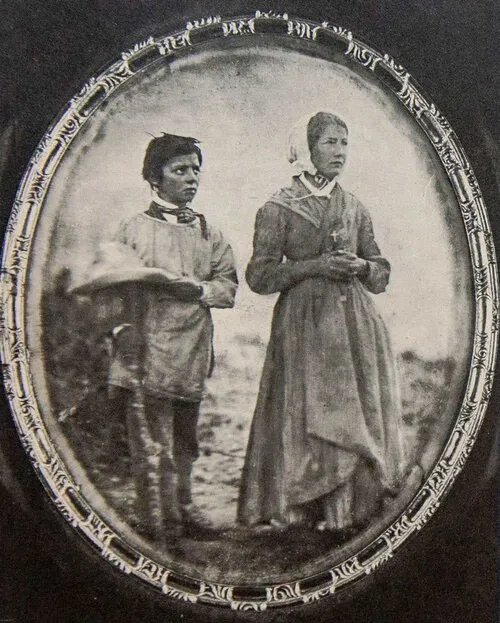
Pilgrimages
News of the event spread very quickly. Since September 21 (two days after the “apparition”), several inhabitants of La Salette went to the mountain, to the declared place of the apparition. With astonishment, they note that clear water gushes abundantly at the very place where the “Beautiful Lady” was seated. On November 17 (a month later), a woman who has only been walking for 22 years with the help of crutches, asks penitents to go to the place of the apparition to pray for her.
The healing of this woman, at the end of this pilgrimage and these prayers, will be the first “declared miracle” of La Salette. On November 27, 1,500 people gathered on the scene under the snow, coming from Corps and neighboring parishes. September 19, 1851, the Bishop of Grenoble publishes a text recognizing the apparition and at the same time authorizing the cult of Our Lady of La Salette. On May 1, 1852 the solemn blessing of the first stone of the sanctuary which is being built on the mountain of the apparition is announced. The foundation stone laying ceremony took place on May 25, 1852, in front of 1,500 pilgrims.
Mid-1848, two years after the apparition, while it was still not (officially) recognized by the Church, the Bishop of Grenoble wrote that there were already 100,000 pilgrims who had visited the site to pray there.
To welcome pilgrims to the sanctuary, Bishop Mgr Philibert de Bruillard asked in 1852 for the creation of a religious clerical congregation intended to receive pilgrims and teach the “message of La Salette”. It will be the missionaries of Our Lady of La Salette founded in these same years. The congregation is organized little by little around the sanctuary, and from the end of the 19th century, it begins to extend in France and outside the country.
But the laws of 1905 and the law of separation of Church and State expels all members of religious congregations of national territory, and the missionaries of La Salette left their founding sanctuary. They are replaced by diocesan priests. The 1914 war softened the relations of the Republican State with the Church, and gradually the religious returned. The congregation of La Salette did not return to the sanctuary until 1943.
In August 1872 the first “great national pilgrimage” takes place in La Salette. This is renewed the following year. In 1946, on the occasion of the centenary of the apparitions of La Salette, the apostolic nuncio in France Mgr Roncalli future John XXIII, comes to the sanctuary to celebrate the mass of August.
In 2016, on the occasion of the Jubilee of Mercy decided by Pope Francis, the sanctuary of La Salette opened a Holy Door in the sanctuary (the second in the diocese of Grenoble) on March 19.
Today, the reception of pilgrims is carried out by the priests and nuns of the missionaries of Notre-Dame de la Salette, as well as by lay people attached to this congregation.
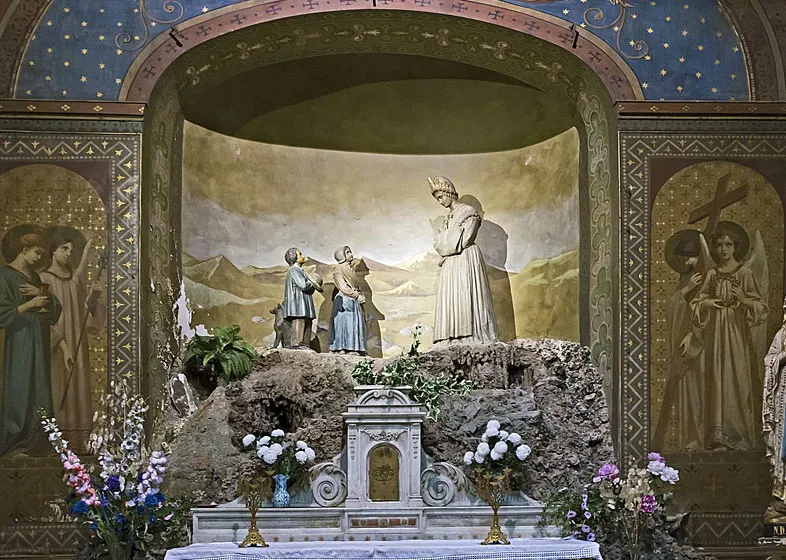
Access
In 1846 at the time of the apparition, it takes 8 hours by stage coach to travel the 65 km from Grenoble to Corps. Access to the site of the apparitions (which will become the sanctuary), is then only possible by mountain paths which must be covered on foot or, failing that, on a mule. In 1863, it was reported that “a ramp cut in the rock” had been opened with mines and explosives, “letting see at each step, on the granite wall, the unerased trace of the mine the rocks hewn as with an axe”.
In 1867, a first road was opened. It’s more of a track with slopes of more than 15%, and even up to 30% for the “Passage of the Grippet”. This track is sketchy, without protection against the precipices, and horse-drawn carriages climb it with great difficulty.
In 1920, tests were carried out with very narrow coaches with about ten seats, to transport pilgrims there, via this bad track. Tracked vehicles are also tested, but none resist the slope and rocky ground for long. The road is gradually being improved: installation of gabions, widening of bends, crossing areas for coaches, the Grippet sector is widened. In 1932 the widening of the road made it possible to take the “griplet” hairpin without having to maneuver!
During this time, the inhabitants of the Valbonnais are trying to obtain the construction of a cable car extending the Mure railway, which has recently arrived in their country and would end at the Salette ridge. This project will not succeed.
In the years 1959-1960, the construction of a new road is started, it will be finished only in 1968. It is the current road which passes by Saint-Julien. Today, it is possible to climb (without difficulty) by car or bus to the sanctuary.
The historic paths are still used by some pilgrims and hikers. The GR 50 (Tour of the Écrins National Park) connects Valbonnais to Valgaudemar via La Salette.
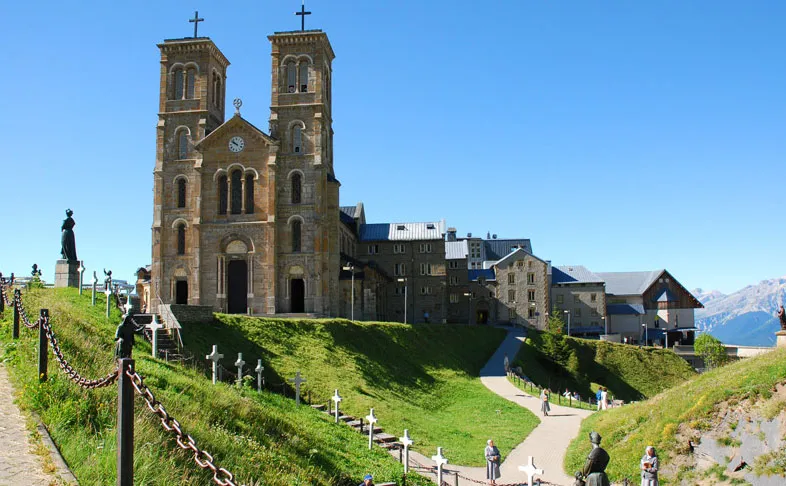
The Basilica
The Basilica of Notre-Dame de la Salette is a large basilica-plan church. Its neo-Romanesque facade is framed by two large symmetrical porch towers housing bells at the top.
The eastern parts of the building were attached to the original church after its construction. They consist of administrative and reception buildings (including a private museum), and are linked to the church by corridors and doors. In extension of the main administrative building, connected to the large corridor serving reception, the refectory, the waiting room, is the “chapel of the Meeting” built in 1995, as well as the shop, the restaurant, and the hotel which allows to accommodate pilgrims.
The “Chapelle de la Rencontre” built in 1995 is the work of the architect René Maison. Built on concrete pillars, the chapel has a polygonal shape, open to the outside by two large glazed sections. This chapel has a platform in the form of an arc. The stained glass windows are the work of the artist Arcabas.
Interior
The basilical plan of the church is composed of five naves terminated by an apse or apsidioles. The church is made up of very slender interior volumes. Its groined vaults fall on very tall and slender columns, resting on high pedestals. The high windows are blind, the lighting only comes from the windows of the first aisles. The apse of the church is made up of two apsidioles on either side of a choir with a straight span and apse in a cul-de-four.
The apse is decorated with a mural of “Christ in glory”, and on the right bay we find a representation of the symbols of the tetramorph, the work of Arcabas. The outer aisles are decorated with several works “Christ at the wedding at Cana”, “the lamentation of Mary on the Cross”, and in the choir: Christ and the four living creatures of the Apocalypse.
The stained glass windows present works by different artists: the Rosary cycle (in the choir apse), designed in 1857 by Adrien-Louis Lusson, the Passion of Christ cycle by the Thibaud de Clermont-Ferrand workshop, and many windows from the Grenoble workshops Antoine Bernard and Bessac (1895 – 1897).
The “chapel of the meeting” is very bright with large windows. In this chapel is a painting representing the Virgin of the apparition, in tears.
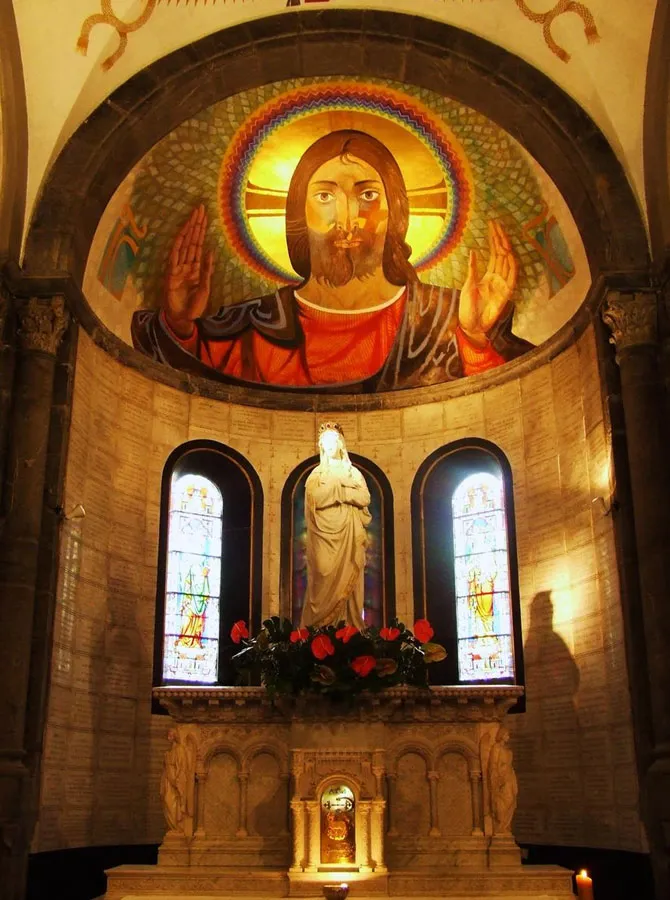
Cemetery of the Fathers and the Chapel
At the front of the basilica (100 m to the north), in the “cemetery of the Fathers” is the first chapel (rebuilt, then moved here). This small square aedicula, three meters on a side, is built of limestone cut stone in two different colors (marbled and grey-blue). It is open on three sides by windows with very architectural frames. The chapel houses a life-size statue of the Virgin which entirely occupies the small interior space.
Statues
In the hollow of a ravine, several statues illustrate the scene of the apparition: a seated woman holds her head in her hands, a little further on; a group of statues represents the Virgin confiding her message to the two young shepherds. On the square, the statue of the Virgin Mary locates the place of the apparition.
A way of the cross is installed in the mountain pastures.
Fountain
The fountain is an arrangement of the so-called “miraculous” source that sprang up after the apparition. The water from this source was already used in the first years following the apparitions, and its access to pilgrims was the subject of fierce and passionate debate between the detractors of La Salette, and the religious responsible for the site.
Reception of Pilgrims
There are approximately 300,000 pilgrims a year to the shrine. They come from all over France and abroad.
At the sanctuary, the welcome is provided by the religious (men and women) of the Missionaries of Our Lady of La Salette, assisted by employees and volunteers. They provide help and support to pilgrims who so wish and bring “to life the message that the Virgin Mary wanted to transmit to the men and women of this world”.
In addition to the audio visual relating the apparition, at 9 a.m. and 2 p.m., the various events that punctuate the day are the mass at the basilica at 10:45 a.m., the meetings between pilgrims at 3 p.m., the rosary at 6 p.m. and the procession by torchlight at 8:30 pm Many pilgrimages are organized, the main solemn gatherings being Easter, August 15 (for the Assumption), and September 19 (for the patronal feast commemorating the 1846 apparition).
Spirituality
According to those responsible for pilgrimages, pilgrims go to this place to “seek light and reconciliation with God”, to confide their doubts, their errors, their fears and their sufferings to “a mother”. For the Church, the message of La Salette is a “message of hope in a society affected, at the time of the apparition as today, by famine, suffering, death”.
Although there are few sick pilgrims (contrary to Lourdes), pilgrims have the “possibility of joining the prayers of the religious community, of participating in the prayer of the rosary, in the vigils, Torchlight processions are among the highlights. During the season, a rotation of foreign priests quite regularly offers services in foreign languages.
Feast Day - 19th September
Our Lady of La Salette (French: Notre-Dame de La Salette) is a Marian apparition reported by two French children, Maximin Giraud and Mélanie Calvat, to have occurred at La Salette-Fallavaux, France, in 1846.
Annual Feast Day of Our Lady of La Salette celebrated on 19th September.
Mass Time
Weekdays
- 7:00 am
- 10:30 am
- 6:00 pm
Sundays
- 7:00 am
- 10:30 am
- 4:00 pm
Church Visiting Time
Contact Info
11459 Route du Sanctuaire,
38970 La Salette, France.
Phone No.
Tel : +33 4 76 30 00 11
Accommodations
How to reach the Sanctuary
Grenoble (GNB) Airport (Grenoble Alpes Isère Airport) in Saint-Étienne-de-Saint-Geoirs, France is the nearby Airport to the Sanctuary.
Parsac – Gouzon Train Station in Parsac-Rimondeix, France is the nearby Train Station to the Sanctuary.

